Google previews Chrome OS: Cloud computing, but without touch
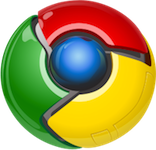 An operating system reduced to and optimised for the web browser – that's the idea behind Google's Chrome OS. While, at first glance, this doesn't promise to be of much use, Google has incorporated technologies in Chrome OS which allow users to work without an internet connection and to install certain types of apps that can be used when offline. However, Google isn't planning to present an alternative to Android, at least for now, touch screen tablets and smartphones are not supported.
An operating system reduced to and optimised for the web browser – that's the idea behind Google's Chrome OS. While, at first glance, this doesn't promise to be of much use, Google has incorporated technologies in Chrome OS which allow users to work without an internet connection and to install certain types of apps that can be used when offline. However, Google isn't planning to present an alternative to Android, at least for now, touch screen tablets and smartphones are not supported.
Acer and Samsung plan to release the first notebooks with Chrome OS in mid-2011 but haven't provided price or configuration details, except that 3G data, 802.11n Wi-Fi (which will come as standard with Chrome OS) and an Intel processor will be included. The operating system is to be available free of charge although, due to missing drivers, users won't be able to install it directly on other notebooks. Google says it hopes to attract an active developer community, but has stipulated that a TPM chip will be mandatory. Only a few business notebooks currently have such a chip, and netbooks in particular may not be able to run Chrome OS.
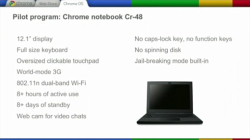
![]() The developer device may give an impression of the specifications of future Chrome OS notebooks.
Google has presented a developer notebook which is to be handed out to (a limited number of) interested users and developers free of charge. However, this pilot programme is currently only open to US residents. The notebook is called Cr-48 (the symbol for the chromium isotope), has a 12.1-inch display, a large touch pad, a built-in 3G data connection, a webcam, 802.11n Wi-Fi functionality and a full size keyboard (without CAPS LOCK and function keys, as Google pointed out). Its battery life is said to be eight hours, with more than a week of standby. The device does not include a hard drive or an optical disk drive – the notebooks use flash memory (SSDs). However, the company said that it doesn't plan to offer its own Google-branded devices (as it does with the Android based Nexus smartphone series), and that the Cr-48 will be a non-commercial developer device only.
The developer device may give an impression of the specifications of future Chrome OS notebooks.
Google has presented a developer notebook which is to be handed out to (a limited number of) interested users and developers free of charge. However, this pilot programme is currently only open to US residents. The notebook is called Cr-48 (the symbol for the chromium isotope), has a 12.1-inch display, a large touch pad, a built-in 3G data connection, a webcam, 802.11n Wi-Fi functionality and a full size keyboard (without CAPS LOCK and function keys, as Google pointed out). Its battery life is said to be eight hours, with more than a week of standby. The device does not include a hard drive or an optical disk drive – the notebooks use flash memory (SSDs). However, the company said that it doesn't plan to offer its own Google-branded devices (as it does with the Android based Nexus smartphone series), and that the Cr-48 will be a non-commercial developer device only.
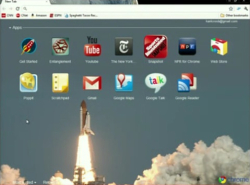
![]() Users can access installed apps from the new tab page in Chrome.
According to Google, one of the major advantages to the Chrome OS is its high level of security (user data is fully encrypted, the system checks the firmware when booting and the browser uses sandboxes, etc). Additionally, its fast boot and standby procedures, its low maintenance (updates are installed automatically) and its easy personalisation (can be synchronised with a Google account) are all key features. Non-synchronised, but otherwise fully functional guest access will reportedly also be possible without a Google account. At least the developer notebook has an integrated jailbreak mode which allows other operating systems to be installed (after flicking a switch underneath the battery), although the Chrome OS will subsequently become unavailable.
Users can access installed apps from the new tab page in Chrome.
According to Google, one of the major advantages to the Chrome OS is its high level of security (user data is fully encrypted, the system checks the firmware when booting and the browser uses sandboxes, etc). Additionally, its fast boot and standby procedures, its low maintenance (updates are installed automatically) and its easy personalisation (can be synchronised with a Google account) are all key features. Non-synchronised, but otherwise fully functional guest access will reportedly also be possible without a Google account. At least the developer notebook has an integrated jailbreak mode which allows other operating systems to be installed (after flicking a switch underneath the battery), although the Chrome OS will subsequently become unavailable.
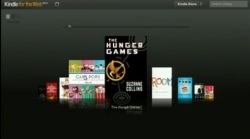
![]() Kindle for Web: Amazon customers will soon be able to read their e-books in their browser or on their Chrome OS notebook.
Synchronisation also includes the apps: Google has launched a web store for apps that run both under Chrome OS and in the Chrome browser under Windows, Mac OS and Linux – however, the vendor has explicitly ruled out the WebKit-based Android browser and Google TV. The apps are said to be web applications that use such technologies as WebGL, HTML5 and Flash and can also be launched in other browsers which support these technologies; only the app installation is apparently specific to Chrome. Google demonstrated a news app for the New York Times, various games by such vendors as Electronic Arts – and a Kindle app which allows users to read e-books purchased at Amazon. Citrix demonstrated various business applications as well as the remote access to a virtualised Windows computer.
Kindle for Web: Amazon customers will soon be able to read their e-books in their browser or on their Chrome OS notebook.
Synchronisation also includes the apps: Google has launched a web store for apps that run both under Chrome OS and in the Chrome browser under Windows, Mac OS and Linux – however, the vendor has explicitly ruled out the WebKit-based Android browser and Google TV. The apps are said to be web applications that use such technologies as WebGL, HTML5 and Flash and can also be launched in other browsers which support these technologies; only the app installation is apparently specific to Chrome. Google demonstrated a news app for the New York Times, various games by such vendors as Electronic Arts – and a Kindle app which allows users to read e-books purchased at Amazon. Citrix demonstrated various business applications as well as the remote access to a virtualised Windows computer.
Being installed locally, the apps can also be used without an internet connection – if it makes sense, and if the app allows any changes to be updated when an internet connection becomes available. Google plans to fully adapt its Docs cloud service within the coming weeks. The web store launched with 500 apps, and many of them are to be available free of charge.
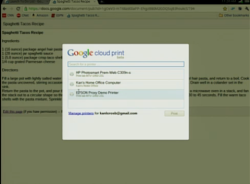
![]() Printing is to be available via Cloud Print.
Chrome OS is, therefore, principally a thin client and implements an idea that's nearly 30 years old, as Google CEO Eric Schmidt had to concede. Schmidt explained that, at the time, the idea failed because nobody was able to build cool and powerful applications, and that its only recently that networks and consumer devices have become fast enough.
Printing is to be available via Cloud Print.
Chrome OS is, therefore, principally a thin client and implements an idea that's nearly 30 years old, as Google CEO Eric Schmidt had to concede. Schmidt explained that, at the time, the idea failed because nobody was able to build cool and powerful applications, and that its only recently that networks and consumer devices have become fast enough.
This is probably also the reason why smartphones and tablets remain unsupported: The Google developers only see the required performance under Chrome OS or Windows, Mac OS and Linux, but consider ARM tablet clients and even slower smartphones too weak. Another reason given by Google is that such user interfaces as touch screens or virtual keyboards simply aren't supported yet. Chrome OS is only the first step on the long road to cloud computing, said Google.
Videos of Chrome, Chrome OS and the new Chrome Web Store are available on the Google Chrome Channel on YouTube.
See also:
- Linux and the Trusted Platform Module (TPM), a feature from The H.
(crve)
![Kernel Log: Coming in 3.10 (Part 3) [--] Infrastructure](/imgs/43/1/0/4/2/6/7/2/comingin310_4_kicker-4977194bfb0de0d7.png)

![Kernel Log: Coming in 3.10 (Part 3) [--] Infrastructure](/imgs/43/1/0/4/2/3/2/3/comingin310_3_kicker-151cd7b9e9660f05.png)
















